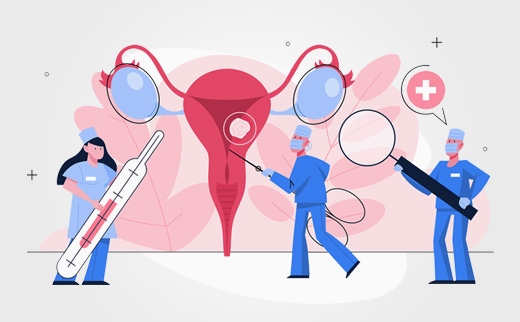
Hysteroscopy is an important tool for diagnosis and for treatment of common intrauterine lesions. Very small or occult lesions that are missed on transvaginal ultrasonography can clearly be visualized on hysteroscopy.
A hysteroscope is a thin, lighted telescope-like device. It is inserted through vagina into uterus. The hysteroscope transmits the image of uterus onto a screen. With advances in anesthesia, technology and instruments, the list of indications for which hysteroscopy can be performed for diagnosis and treatment is ever increasing. With the advent of small-caliber scopes, office hysteroscopy can become the first-line diagnostic tool for uterine cavity evaluation in infertility.
To diagnose: (Diagnostic hysteroscopy) focal intrauterine lesions, e.g. polyps, fibroids; abnormal premenopausal or postmenopausal uterine bleeding; investigation of infertility; investigation of recurrent miscarriage; pelvic pain.
To treat: (Operative hysteroscopy) removing fibroids, polyps; retrieval of a lost intrauterine contraceptive device (IUD); intrauterine adhesions; Müllerian anomalies (eg, uterine septum); ablation of the endometrium; hysteroscopic sterilization; retained products of conception; Endocervical lesions.

Cervical cancer: Hysteroscopy should not be performed in the presence of cervical carcinoma because of the danger of opening blood or lymphatic vessels and causing systemic dissemination of malignant cells.
Heavy uterine bleeding: Hysteroscopy should be avoided during menstruation, because of a theoretical risk of dissemination of endometriosis and mainly because the view is usually unsatisfactory. Moderate uterine bleeding does not prevent adequate visualization of the endometrial cavity.
Pelvic inflammatory disease: Because of the danger of causing extended ascending infection and peritonitis.
Active herpetic infection
Pregnancy: Generally considered a contraindication to hysteroscopy but it might be necessary to perform hysteroscopy to remove an IUD or to diagnose retained products of conception when there has been persistent postabortal bleeding, although ultrasound has replaced endoscopy in many such cases. The myometrium in the gravid uterus is much more distensible than in the non-pregnant organ. Uterine distension with gas can cause the uterus to distend like a balloon, which can result in retroplacental bleeding or a massive gas embolus.
It is important, therefore, that hysteroscopy in pregnancy is performed only by an expert surgeon and that the gas flow is restricted to 20 mI/minute. It is also important to remember that the optic nerve of the fetus can be damaged by the hysteroscope light after the tenth week of pregnancy.
Recent uterine perforation: The risk of repeat uterine perforation is considerably greater in such patients as the healing process might have left a weak scar.
Cervical stenosis: The risk of uterine perforation is considerably greater in such patients. The role of experienced operator can not be more reinforced.
Preoperative consultation allows the patient to understand the hysteroscopic procedure, weigh the inherent risks and benefits, and let the doctor to review the patient's medical history for any comorbid conditions or any contraindications to hysteroscopy mentioned above such as known pregnancy, genital tract infections, active herpetic infection or etc.
The hysteroscope is gently inserted through the cervix into the uterine cavity. Carbon dioxide gas or a fluid, such as saline put through the hysteroscope to expand the uterus. The gas or fluid helps to see the cavity more clearly. The amount of fluid used is carefully checked throughout the procedure. The lining of the uterus and the openings of the fallopian tubes are evaluated through the hysteroscope. If a biopsy or other procedure has to be done, small devices are passed through the hysteroscope.
Hysteroscopy is not painful. A general or local anesthetic may be used to block the pain. The extent of anesthesia you need will depend on the purpose of your hysteroscopy.
Some cramping lasting short may occur after the procedure. You may be given some type of pain killers.
During operative hysteroscopy hemorrhage (2.4%),uterine perforation (1.5%),and cervical laceration (1–11%) can occur. Complications from fluid overload should be considered as well. Other complications include visceral injury, infection, CO2 and air embolism, and, very rarely, death. Delayed complications may include intrauterine adhesions and infertility.
Mild cramps and vaginal bleeding may ocur for a day or two after the procedure. Any condition such as fever, severe abdominal pain, or heavy vaginal bleeding or discharge should be informed to the doctor.
In premenopausal women with regular menstrual cycles, the optimal timing for diagnostic hysteroscopy is during the follicular phase of the menstrual cycle after menstruation. Hysteroscopy during the secretory phase of the cycle can make diagnosis more difficult because the endometrium is thick and can mimic polyps. Some women with unpredictable menses can be scheduled at any time for operative hysteroscopy.
The recovery time depends on the type of treatment performed such as fibroids removal and/or a general anaesthetic that used. After office hysteroscopy most women feel good and return to normal activities, including work, the day after the procedure. Some women prefer a few days off to rest, particularly after operative hysteroscopy and general anaesthesia.